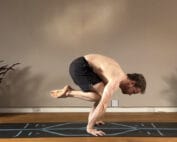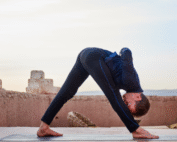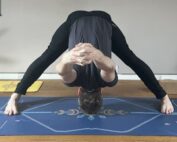
Mastering Bound Side Angle Pose (Baddha Utthita Parsvakonasana)
Hello! I’m Dav Jones, a yoga teacher and trainer dedicated to helping you find strength, balance, and inner peace through yoga. Today, we’re exploring the Bound Side Angle Pose or Baddha Utthita Parsvakonasana. This posture is a great posture that helps to create mobility, strength and flexibility. Whether you’re new to this pose or looking to refine your technique, this guide will provide everything you need to know. Let’s dive in!
What is Bound Side Angle Pose?
The Bound Side Angle Pose is a standing asana that combines a twist with a bind, offering a combination of grounded strength through the legs and feet along with sufficient mobility through the shoulders to find the bind. There is a prerequisite in preparing the shoulders and spine for this pose in order to competently execute the binding version of this posture. There are also many regressive versions of Side Angle Pose that can be practiced in the build-up towards the binded version of this posture.
Pose Basics:
- Sanskrit Name: Baddha Utthita Parsvakonasana
- Pronunciation: Bah-dah Oot-tee-tah Par-sva-ko-nah-suh-nah
- Pose Type: Standing, twisting, and bind
- Level: Intermediate to Advanced
- Focus Areas: Hip flexibility, spinal alignment, and core strength
The pose is a staple in many yoga sequences, loved for its grounding attributes and ability to stretch tight muscles around the inner hips and shoulders.
The Physical and Mental Benefits of Bound Side Angle Pose
Physical Benefits:
- Improves Flexibility: This pose opens the hips, shoulders, and chest, improving the range of motion.
- Strengthens the Body: Tones the legs, arms while also bringing increased range of motion through the hips, ankles and spine.
- Detoxifies: The twisting motion massages internal organs, and can help to stimulate digestion and circulation.
Mental Benefits:
- Promotes Focus: The grounding attributes of this posture helps to bring your awareness into the present moment.
- Reduces Stress: Due to the grounding nature of this posture, it can help to bring the nervous system into a state of homeostasis – nervous system regulation.
- Builds Confidence: Successfully holding this pose fosters control and stability through one’s posture, promoting an empowered sense of self and confidence.
Preparatory Poses for Baddha Utthita Parsvakonasana
Before attempting Bound Side Angle Pose, it’s important to prepare your body with stretches that target key areas like the hips, shoulders, and spine. Here are some essential preparatory poses:
-
Warrior II (Virabhadrasana II):

Strengthens and engages the legs while improving balance.
-
Lizard Pose (Uttana Padasana)

This is a great preparation pose for Bound-Side Angle Posture. Stretching the fascial tissue at the front of the hip joint in the rear leg and the fascial tissue in the inner/rear hip region in the front leg.
-
Extended Side Angle Pose (Utthita Parsvakonasana):

More of an intermediate pose, this pose prepares the torso for twisting and enhances spinal mobility.
Step-by-Step Guide to Bound Side Angle Pose

Standing Variation:
- Begin in Warrior II:
Stand with your feet around 3.5/4 feet apart, your front foot facing forward, and your back foot parallel to the rear short-edge of your mat. Keep your arms abducted at shoulder height. - Lower into Extended Side Angle Pose:
Bring your front elbow to rest on your front thigh or place your hand on the floor inside of your front foot. - Initiate the Bind:
Internally rotate the front shoulder and thread the arm under the thigh in the front leg. Collect the hand/wrist with the rear hand. - Rotate Your Body:
Open your chest towards the ceiling, rotating your spine, and grounding your feet firmly into the mat. - Hold and Breathe:
Stay in the pose for 5–10 breaths, focusing on deep inhalations and exhalations. Repeat on the other side.
Introducing the Use of Props Modifications for Bound Side Angle Pose
Modifications
- Yoga Strap: Use a strap to connect your hands if they don’t quite reach.
- Block Support: If the bind is restricted due to limitations, practice a regressed version of Side Angle Pose – place a block under your front hand to ground through the arm and shoulder.
- Wall Support: Practice with your back against a wall for stability and alignment.
Variations Options
- Parvritta (Twisted) Bound Side Angle Pose: Add a deeper twist by placing your opposing arm-to-leg, placing to the outside of your front knee.

2. Bird of Paradise Pose: Transition from ‘Bound Side Angle Pose’ to ‘Bird-of-Paradise.

Incorporating Bound Side Angle Pose Into Your Routine
- Morning Boost: Start your day with this pose to energize and detoxify your body.
- Strength Flow: Pair it with Warrior II and Triangle Pose to increase blood flow to your hips and shoulders.
- Post-Workout Stretch: Use it after exercise to release tight hips and relax your lower back.
Breathwork and Mindfulness in Bound Side Angle Pose
Intentional breath enhances this pose by connecting breathing to the expansion of your ribcage which in-turn helps to increase blood flow and joint mobility.
- Inhale: Ground yourself through your feet, and expand your inhale into your side ribs.
- Exhale: Keep the bind, and gently increase the rotation through your spine.
Final Thought
We’ve explored Bound Side Angle Pose, delving into its steps, benefits, and variations to enrich your yoga practice. This pose embodies balance, growth, and resilience, making it a cornerstone of the Yoga Asana Practice.
If you’re ready to deepen your practice, explore Dav Jones online yoga classes on Patreon, where personalized sequences await to help you grow with confidence. For a more tailored approach to your yoga path, consider the Dav Jones Yoga Mentorship Program for individual support and guidance. Let ‘Bound Side Angle Pose’ guide you toward inner stability and strength.









